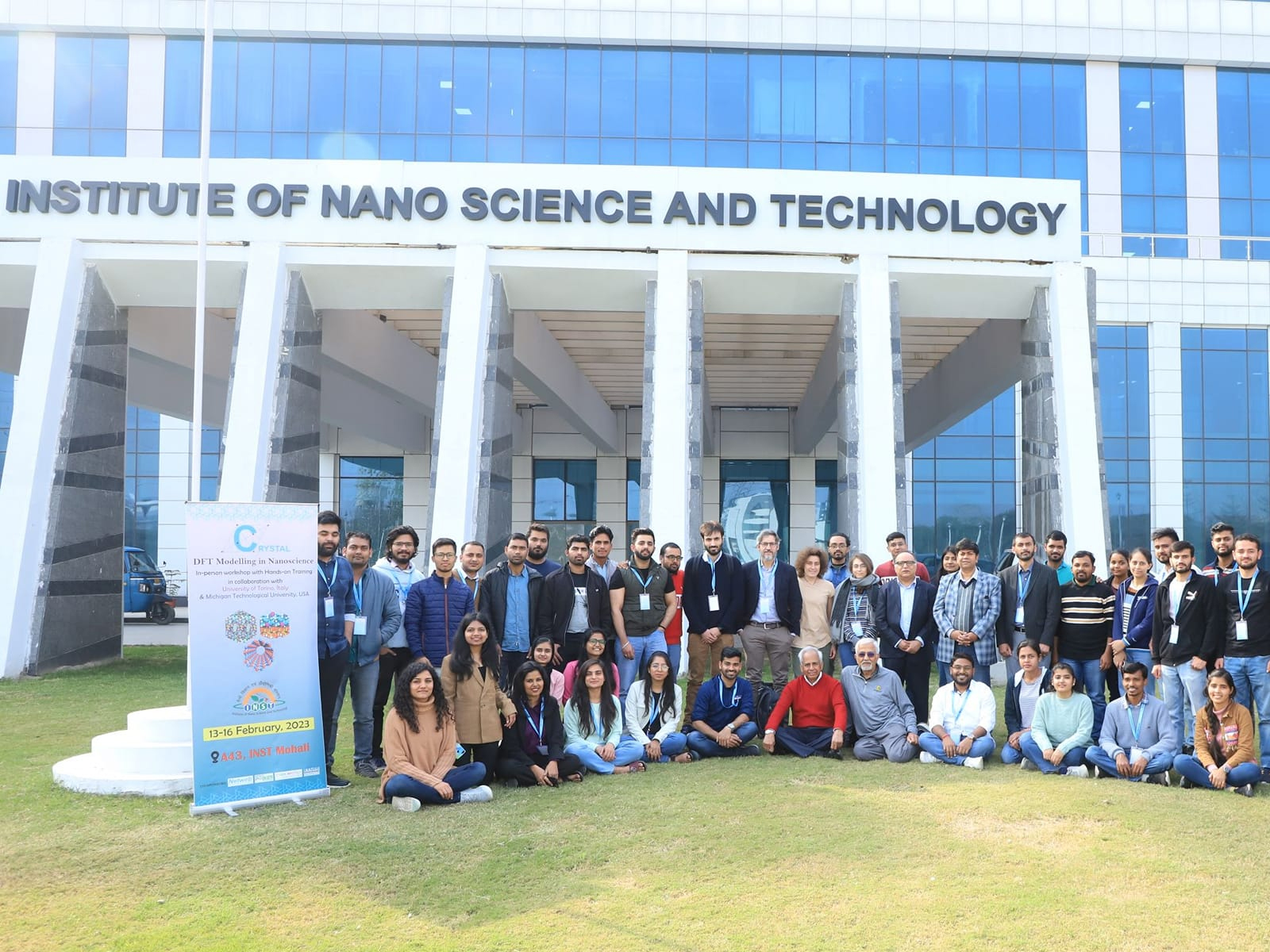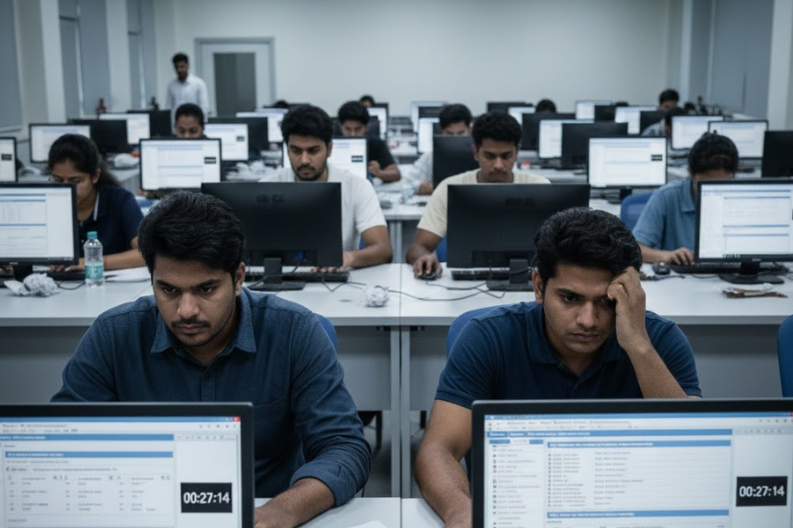Education
INST Mohali | Institute of Nano Science & Technology

This article covers everything about INST Mohali. Get to know about its history, admissions process, courses offered, eligibility criteria, contact details, events, and other important information.
Prestigious History of INST Mohali
In accordance with the 2007 “Nano-Mission” launched by the government of India, a broad objective of basic research promotion, human resource development, promotion of international collaboration, direct industrial involvement in the development of Nano applications, and more were set as a growth plan.
With respect to working on the same lines, the government of India agreed on the establishment of INST in Mohali, which is a knowledge city. Moreover, it has been registered under the Societies Registration Act XXI of 1860. By the Registrar of the Societies of SAS Nagar vide Certification No. 2590, which dates back to 21st August 2009.
The Institute of Nano Science and Technology (INST) was established in January 2013. Also, it is an autonomous institute in Mohali, Punjab. It was the Department of Science and Technology (DST), Government of India, that took the initiative to start this institute under the Nano mission to improve India’s reach, research, and development in the field of Nano Science and Technology.
In 2020, the campus of INST shifted to Sector-81 of Mohali, which has over 35 acres of land. The Institute of Nano Science and Technology includes research programs in Physics, Chemistry, Biology, and interdisciplinary sciences. Additionally, it discusses issues in chemical biology, quantum materials, the environment, nano-devices, and the field of energy.
Aim and Mission of the Institute
INST Mohali aims to emerge as the country’s foremost research Nano Science and Technology institute. It is a place where engineers, biologists, chemists, physicists, and material scientists together have an affinity toward the field of Nano Science and Technology.
The primary aim of this institute is to come up with new technologies, solutions, and processes in different sectors of – healthcare, defense, energy, environment, water, and agriculture.
INST comes up with a lot of activities that contribute to some of the major programs of importance to the nation, such as Swasth Bharat, Swachh Bharat Abhiyan, Smart Cities, Smart Villages, Make in India, Clean & Renewable Energy, etc. Additionally, the institute offers robust solutions and technologies to combat issues related to these programs.
They also have a philanthropic program called the “School adoption program,” which was launched in the year 2015. Through this program, the institute provides the required infrastructure, technological information, and incentives to Government schools in India.
The institute also formulates programs for rural and remote areas targeting the young generation to make them aware of the development of technological solutions.
The exclusive mission of INST Mohali is to ideate solutions, devices, and technologies for defense and commercialization. They also aim to generate affordable devices for the healthcare sector.
Noteworthy Objectives of the Institute of Nano Science & Technology
Some of the schemes on which the institute works are as follows –
- Building of infrastructure and Manpower
- Promotion of research activities in the field of nanoscience and technology
- Giving excellent training to the Ph.D. students
- Imparting advanced training and laboratory techniques at the highest level possible
- Organizing and promoting the students under training to attend national and international level conferences and seminars
- Encouraging novel and challenging innovations and tech/product-based projects
- Publishing scientific research papers that have an impact
- Generation of patents in Nano Science and Technology
- Incubating translational research that reaches the industries from the lab
Modern and High-Tech Facilities at INST
The Institute of Nano Science and Technology promotes research and technology in the field. Since the mission of the facility is so high, advancement in infrastructure and research inventory is important. As a result, the institute has the following technological advancements.
- Research Lab with a microscope, scattering system, analyzers, fluorometer, calorimeter, rheometer, electrochemical workstation, diffractometer, and surface profiler.
- Laboratory with Electron microscopes such as SEM (Scanning Electron Microscope), TEM (Transmission Electron Microscope), and AFM (Atomic Force Microscope).
- Spectroscopies include UV-Vis spectroscopy, Raman spectroscopy, UV-Vis spectroscopy, and Photoluminescence spectroscopy.
- XRD (X-ray diffractometer), Thermogravimetric analysis, Differential Thermogravimetric analysis.
- Library with around 400 books in Nanoscience and Nanotechnology, Seminar Hall, computer center with good speed internet for study or related work. Auditoriums, State-of-art instruments.
Administration of INST Mohali
There is a board of Governors consisting of researchers, administrators, and academicians who manage the Institute of Nano Science and Technology. Prof. Uday Maitra is the chairman of this institute, and the founding chairman is C.N.R. Rao of Jawaharlal Nehru Centre for Advanced Scientific Research (JNCASR), Jakkur, Bangalore.
Ashok K Ganguli was the director of this institute when it started in January 2013. From January 2018 to March 2020, Hirendra Nath Ghosh was the director. Amitava Patra has been the current director since 11 March 2020. The family of INST can reach out to him through [email protected] for direct communication.
INST Faculty
The Institute of Nano Science and Technology has a notable faculty consisting of scientists and researchers. The faculty here is well-experienced and well-qualified, with Ph.D. degrees and various research papers published in the field of Nano Science and Technology.
There are a total number of 36 scientists and a total of 14 administrative staff.
Professor Amitava Patra is the Director of INST in Mohali. Some of the notable faculty members from the Institute of NanoScience and Technology are:
Dr. Debabrata Patra is the associate professor of this institute. His academic qualifications are B.Sc, M.Sc, Ph.D.
Prof. H. N. Ghosh is the Professor at this institute. His academic qualifications are B.Sc, M.Sc, Ph.D.
Dr. Jayamurugan Govindasamy is the associate professor of this institute. His academic qualifications are B.Sc, M.Sc, Ph.D.
Dr. Kamalakannan Kailasam is the professor at this institute. His academic qualifications are B.Sc, M.Sc, Ph.D.
Dr. Menaka Jha is the Scientist-C of this institute. Her academic qualifications are B.Sc, M.Sc, Ph.D.
Dr. Monika Singh is the Scientist-C of this institute. Her academic qualifications are B.Sc, M.Sc, Ph.D.
Dr. Prakash P. Neelakandan is the Associate Professor of this institute. His academic qualifications are B.Sc, M.Sc, Ph.D.
Dr. Ramendra Sundar Dey is the Scientist-C of this institute. His academic qualifications are B.Sc, M.Sc, Ph.D.
Dr. Sonalika Vaidya is the Assistant Professor (Scientist-D) of this institute. Her academic qualifications are B.Sc, M.Sc, Ph.D.
Dr. Tapasi Sen is the assistant professor (Scientist-D) of this institute. Her academic qualifications include B.Sc, M.Sc, and Ph.D.
Dr. Vivek Bagchi is the Scientist-C of this institute. His academic qualifications are B.Sc, M.Sc, Ph.D.
Significant Areas of Research of the Institute
The major areas of research where The Institute of Nano Science and Technology, Mohali, wants to research are Device Physics, Sensors, Agriculture Nanotechnology, Medical Nanotechnology, Nano Biotechnology, Quantum materials and Device Physics, Nano technology-based solutions, and devices related to energy and environment.
Also, under the umbrella of research, INST Mohali provides the opportunity to dive into industrial and sponsored projects. Well-researched publications of various eminent scientists are available on its official website.
Units of The Institute of Nano Science and Technology
The three departments or units of this institute are Energy and Environment Unit, Chemical Biology Unit, and Quantum Material and Devices Unit. Although they are the main units, there are specialized diversions related to each one of them.
Courses Offered at INST Mohali
The courses offered at INST are:
1. The first course is a Ph.D. which has a duration of 3 years. For those ones who want to take their respective field ahead and continue the progression of learning, Post Doctoral for a duration of 2 years is also available.
2. Research Internship with a minimum duration of 3 months and a maximum of 12 months is open for all the aspirants
3. Not to miss the Project Fellowship, which is equally useful and beneficial.
Application Procedure
The students are selected on the basis of ranks obtained in entrance exams like GATE/CSIR or UGC-NET/JEST/JGEEBILS (TIFR/NCBS)/ICMR-JRF/DBT-JRF/DST-INSPIRE/GPAT.
For Ph.D. Programs in INST Mohali
Steps for admission to the Ph.D. program:
- You can apply if you have a degree of M.Sc. or M.Pharm or M.Tech degree, in general,/Applied Sciences/Engineering or similar fields. Final-year students who can produce the degree at the time of joining can also apply.
- Visit the official website of INST. Download the application form and fill in all the information required carefully.
- The candidates should send the filled form and Synopsis to [email protected] as an advance copy.
- Then the candidate has to send some of the documents along with the application form. This needs to be sent to the permanent address of the institute, which is – The Habitat Centre, Phase – 10, Sector – 64 Mohali – 160062.
The documents must include the following:
- Photograph of the Candidate
- Age Certificate
- Candidate’s Educational Qualification (Mark Sheet, Degrees and Certificate of Class 10, 12 and Bachelor’s/Graduate degree, Master Degree Final Marksheet.
- Work Experience certificate in case of a working candidate.
- SC/ST/OBC/PH category certificate – valid and self-attested copies.
After the shortlisting process is completed, the selected candidates are invited for an interview. Post the discussion, the candidates are shortlisted again. A form with the names of the selected candidates is displayed on the official website.
The institute pays for the travel expenses of the candidate for the Rail (Sleeper Class) or Non-AC bus. Candidates need to show the tickets as proof.
Bank Details
The candidate must pay the application fees online to the bank account INST Mohali. You must mention your full name during the transaction. For the General, OBC, and EWS categories, there is a fee of INR 590. For SC.ST, and PH categories, there is a fee of INR 295.
Refer to the mentioned-below details of the bank to pay the required amount.
Account Name: Director, INST Mohali
Account Number: 2452201001102
IFSC Code: CNRB0002452
BANK: CANARA BANK, Sector 34A, Chandigarh 160022
Application Procedure in INST for Internship Programmes
If you are a candidate from any Basic Sciences/Applied Sciences/Engineering Institutes/Universities, you are eligible to apply for an internship at INST Mohali. The scientist or supervisor needs to agree to guide the candidate applying for the Internship.
- Candidates seeking an internship can fill out the application form online.
- Upload all the documents as required and make sure that the documents are scanned properly. Low-quality scans or blurred copies of the documents will be rejected.
- The senior authorities go through all the candidates. The institute sends an e-mail to the selected candidates.
Application Dates of Internship Programmes
Summer Internship
Application Date: 1st March – 21st March
Duration of Programme: May – July
Short Term Internship
Application Date: 1st April – 21st April
Duration of Programme: June – December (3-6 months)
Research Internship
Applications are accepted throughout the year.
Duration of program: 1 year
The institute does not provide any stipend to the interns in INST Mohali. Students need to bear their own expenses. There is a Funded Internship program only for the ST candidates where they get an allowance of INR 10,000 every month for Research Projects in Nanoscience and Nanotechnology.
Campus Life at INST Mohali
Besides imparting the best quality technical and scientific knowledge, the campus organizes various seminars and conferences for real experience. From celebrating little things to being a part of international-level meetups, INST is not behind.
Some of the noteworthy events are teachers’ day, Swachh Bharat Program, the 8th MRS trilateral conference, yoga day, and more. Researchers and students of the institute have always found solutions to fight the issues, be it agricultural or any other.
Conclusion
INST in Mohali combines fundamental science with advancements in technologies to deal with problems that are of national and global importance.
For more information, visit the official website of the institute and the Facebook page.
Address
Sector – 81, Knowledge City, Sahibzada Ajit Singh Nagar, Punjab, Pin – 140306
Timings
Monday – Friday (9 am – 5 pm)
Contact No
0172 221 0075, 2210057, 2210056
Website
Daily News
CAT Exam Analysis Slot 3: Students Face Tough QA Section

The CAT exam analysis slot 3 reveals that the final session of CAT 2025 proved moderately difficult for most candidates. IIM Kozhikode conducted the Common Admission Test on Sunday, with the third slot running from 4:30 pm to 6:30 pm. Approximately 2.58 lakh students appeared for the exam across all three slots nationwide. Moreover, the overall attendance reached around 86 percent, showing strong participation.
Candidates found the Quantitative Ability (QA) section particularly challenging in the third slot. Experts from Career Launcher noted that QA emerged as the toughest section of the entire day. The section contained 22 questions that required multi-step reasoning under time pressure. Consequently, students estimated that scoring just 5-6 correct answers could secure the 90 percentile mark.
In contrast, the Verbal Ability and Reading Comprehension (VARC) section remained relatively manageable. Students worked through 24 questions in 40 minutes, following the established pattern from previous years. Furthermore, the reading comprehension passages, though occasionally dense, featured straightforward questions. Experts rated this section as easy to moderate, similar to the earlier slots. Additionally, candidates estimated that 8-9 net correct answers would likely place them around the 90 percentile range.
The Data Interpretation and Logical Reasoning (DILR) section presented moderate difficulty throughout the day. This section comprised 22 questions that demanded careful prioritization. Many students highlighted that certain caselets required extended time to solve completely. Therefore, experts suggested that 5-6 solid correct attempts would be sufficient for the 90 percentile. The logical depth and data complexity exceeded expectations for several candidates.
The exam followed the standard structure across all slots. Each session included 68 questions distributed across three sections, with 120 minutes to complete the test. The marking scheme awarded three marks for each correct answer while deducting one mark for incorrect responses. However, unattempted questions carried no penalty, allowing strategic question selection.
Across India, nearly 6,500 candidates appeared for the exam in the tricity region alone. In Mohali, students took the test at two centers located in Sectors 82 and 83. Meanwhile, IIM Sirmaur and IIM Amritsar continue attracting northern region aspirants. Panjab University’s University Business School also remains a preferred choice, with cutoffs expected around the 85 percentile.
Student reactions varied across sections. Himanshi Sharma from PEC Chandigarh shared that the verbal section went smoothly for her. Nevertheless, she found the Math and DI sections tougher than expected. Similarly, Nishant Rathour from Panjab University described the DI section as particularly tricky, though he felt satisfied with his overall performance.
Compared to CAT 2024, this year’s exam showed a slight increase in difficulty. Specifically, DILR emerged as clearly more difficult than last year, while VARC remained marginally easier overall. QA maintained similar difficulty levels but leaned toward the tougher side, especially in the final slot.
CAT 2024 Slot 3 Analysis: कैट एग्जाम स्लॉट 3 एनालिसिस; वीएआरसी कठिन और डीआईएलआर सेक्शन आसान रहा#CAT #CATExam #CAT2024 #CATExam2024
Read more at: https://t.co/IXjsOPQmgk pic.twitter.com/Tc3JnCmero
— Careers360 (@careers360) November 24, 2024
Early estimates suggest that candidates scoring 25-27 net correct answers across all sections in the third slot may reach the 99 percentile. This reflects the overall challenging nature of the session. The results are expected by the end of December, after which shortlisted candidates will proceed to the essay writing and personal interview stages.
The CAT exam analysis slot 3 indicates that smart question selection proved essential for success. Students who managed their time effectively and prioritized accessible questions likely performed better across all sections.
Education
Ludhiana: Guest Faculty Finally Receive 10-Month Salary Arrears
In Ludhiana, a big win for guest faculty members happened recently.

A major relief arrived in Ludhiana after the guest faculty finally receive 10-month salary arrears, bringing joy to hundreds of teachers who had waited almost a year for their pending payments. The Guest Faculty Assistant Professors United Front celebrated this moment and appreciated the government for responding with care and speed.
Leaders of the United Front: Ravinder Singh Mansa, Gursev Singh Patiala, Paramjit Singh, and Muhammad Tanveer, thanked Higher Education Minister Harjot Singh Bains for his quick action. They said his involvement played a key role in clearing the long-pending salaries, which had caused stress for many teachers.
Guest faculty members have supported Punjab’s education system for more than twenty years. They teach in government colleges across the state and continue to guide thousands of students every year. Because of their long contribution, many believe they deserve stronger recognition and fair job security.
In 2022, the Aam Aadmi Party government increased the honorarium for guest professors. This move showed that the state understands its needs and values its service. However, when the government hired permanent professors later, new administrative steps caused delays. As a result, salaries in 25 colleges got stuck, leaving many guest faculty members under financial pressure.
Fortunately, coordinated efforts between the principal secretary and the director of higher education helped end this problem. They removed procedural hurdles and ensured payments finally reached teachers. The United Front also praised the director of higher education for honest and steady leadership during this difficult period.
Teachers across Punjab shared how delays affected their daily lives. Many said they continued teaching with dedication despite financial hardship. Ravinder Singh urged the government to regularize guest faculty services so teachers who served for decades can gain stable positions. He explained that permanent jobs would reflect the true value of their contribution to higher education.
Guest faculty members have shaped the academic journey of countless students. Because of their constant support, many colleges have been able to run smoothly even during staff shortages. Giving them job security would not only help teachers but also improve student learning.
Better treatment of educators leads to better education for everyone. When teachers feel supported, they can focus fully on teaching, guiding, and inspiring young minds. Moreover, regular pay and stable employment help create stronger academic environments.
In conclusion, clearing the pending salary dues marks a positive step for Punjab’s education sector. It shows that the government is willing to listen and respond to teachers’ concerns. Many hope this progress continues, offering more recognition and long-term support, especially after the guest faculty finally receive 10-month salary arrears.
Daily News
What Is an AI Bubble? A Deep, Clear Explanation

Artificial Intelligence (AI) has transformed from a futuristic dream into a booming global industry. Trillion-dollar valuations, skyrocketing chip demand, and rapidly expanding data centers have convinced many that AI will change the world. And in many ways, it will. But beneath the excitement, the rapid pace of investment and financial engineering has raised an important question: Are we living through an AI Bubble?
Just like the dot-com era of 1999 or the US housing bubble of 2008, an “AI Bubble” refers to a dramatic rise in valuations, investments, and expectations-far beyond what real-world fundamentals justify. When these expectations eventually confront reality, the bubble risks bursting.
This article explains what an AI bubble is, how it forms, why it matters, and how investors and industries should view it.
1. Understanding the Core Idea of a Bubble
A “bubble” is an economic condition where asset prices rise sharply because of hype, momentum, and optimism-rather than actual performance and revenue.
In the context of AI:
- Companies are investing heavily in computing power and data centers.
- Investors are pouring money into AI startups at record valuations.
- Tech giants are spending tens of billions on chips, servers, and software.
- Everyone assumes that AI will soon generate massive profits.
A bubble forms when expectations grow much faster than actual, sustainable earnings.
In other words:
A bubble is created when we assume infinite growth based on finite evidence.
2. Why AI Is Attracting Trillions of Dollars
Before calling it a bubble, we must understand why this technology attracts so much money.
AI promises:
- Faster automation
- Better productivity
- New business models
- Breakthroughs in medicine, education, finance, robotics, and more
- Massive time and cost savings for enterprises
Global companies do not want to miss out on a technological shift that could determine the next generation of winners in the economy.
There’s nothing wrong with this. Innovation requires investment.
The issue begins when these investments turn speculative, detached from realistic outcomes.
3. What Creates an AI Bubble?
a. Exponential Investment vs. Slow Monetization
AI models (LLMs, diffusion models, robotics brains) need:
- Immense GPU power
- Large data centers
- Cheap electricity
- High-bandwidth networking
- Engineering teams
- Safety teams
- Product teams
Yet, despite billions spent, AI revenue is still small. Except for a few giants like Google and Microsoft, most companies haven’t found a profitable business model.
If expenses rise faster than revenue, valuations can become artificially inflated.
b. Circular Financing
In a healthy economy, money flows like this:
Investor → Company → Revenue → Profit
But in bubbles, the flow becomes circular:
Investor → Company A → Company B → Company A
Example pattern:
Company A invests in Company B → Company B uses the funds to buy Company A’s products → Company A’s revenue goes up → valuation goes up → investors put more money.
It creates an illusion of demand-when in reality, the cash keeps cycling inside the same loop.
c. Hidden Debt and Financial Engineering
Some companies don’t want to show massive AI-related debt on their balance sheets. So they create:
- SPVs (Special Purpose Vehicles)
- Leasing structures
- Off-balance-sheet borrowing
- Vendor financing arrangements
This makes their main company appear financially healthy, even when huge risks are quietly accumulating elsewhere.
This is similar to the 2008 housing bubble, where mortgage risks were hidden inside complex derivatives.
d. GPU and Data Center Mania
An AI model isn’t just software-it lives inside expensive data centers packed with GPUs. The cost of building these facilities has exploded.
But here is the issue:
- GPUs depreciate quickly
- New generations release faster than before
- The hardware becomes obsolete
- Data center rental rates fluctuate
- Electricity and cooling costs rise
- AI demand is not guaranteed
If the business model does not justify massive capex, the investment becomes risky.
4. Fake Demand and Overreaction to Geopolitics
AI chips also became expensive because geopolitics created artificial scarcity. Restrictions on selling high-end chips to countries like China created a “shortage premium.” Companies started hoarding chips, not because they needed them immediately, but out of fear of missing out.
This artificial demand can collapse quickly once supply stabilizes.
5. AI Hype Across Non-Tech Industries
In the dot-com era, every company rushed to add “.com” to their name.
Today, something similar is happening:
- AI toothbrush
- AI washing machine
- AI refrigerator
- AI hair dryer
- AI fan
- AI cooker
- AI helmet
- AI vacuum cleaner
Most of these “AI-enabled” products do not provide any meaningful intelligence. But companies do this to attract investor money and media attention.
When hype becomes a strategy, a bubble is already forming.
6. Historical Parallels: How Bubbles Usually Work
Dot-Com Bubble (2000):
- Companies grew without revenue
- IPOs doubled on listing day
- “Internet will change everything”
- But most firms had no profits
- Bubble burst when investors demanded real cashflows
Housing Bubble (2008):
- Excessive borrowing
- Hidden risks
- Overconfidence that prices will always rise
- Collapse triggered a global recession
AI Bubble Today:
- Massive capex
- Hidden debt
- Unrealistic expectations
- Companies using AI tag for hype
- Concern that revenue may not catch up soon
7. Is AI Itself a Bubble? Absolutely Not.
Artificial intelligence is real. It is transformative, and it’s here to stay.
But the financial ecosystem around AI may be inflated.
The internet survived the 2000 crash.
Housing still exists after 2008.
But the companies built on unrealistic promises disappeared.
Similarly, AI will remain essential for the next 50+ years-but many AI businesses may not survive the financial correction.
8. When Can an AI Bubble Burst?
Predicting exact timing is impossible.
But bubbles usually burst when:
- interest rates rise
- profitability lags
- capital becomes expensive
- debt accumulates
- growth expectations fail
- competitive pressure increases
- investors look for safer opportunities
If companies cannot turn today’s multi-billion-dollar investments into sustainable revenues, correction becomes inevitable.
9. What Happens If the AI Bubble Bursts?
Short-term impact:
- Stock market correction
- Valuations of AI startups collapse
- GPU and data center prices drop
- Over-leveraged firms face bankruptcy
- Investors lose money on speculative bets
- Hiring slows across tech sectors
Long-term positive impact:
- Weak, overhyped companies disappear
- Strong products survive
- Innovation becomes more disciplined
- Infrastructure becomes cheaper
- AI becomes more accessible
- Industry stabilizes
- Real business models mature
Bubbles clean the ecosystem and leave behind only what truly works.
10. Will AI Still Grow After a Bubble? Yes-Even Faster.
A bubble does not destroy technology. It only destroys bad investments.
After the dot-com crash, the internet entered its golden period.
>After the crypto crashes, blockchain matured and became more regulated.
>After solar energy crashes, renewable companies finally became profitable.
AI will follow the same pattern:
Temporary hype → Bubble → Correction → Sustainable long-term growth
Final Thoughts
An AI Bubble forms when optimism outpaces logic, financial engineering hides risk, and everyone assumes growth will continue forever. But AI itself is not the bubble. The bubble is the money, debt, valuation, and expectation built around the technology.
AI will change the world. But the journey may include a financial reset-one that separates hype from real innovation.
True revolutions don’t collapse after a bubble.
They only get stronger.
-

 City Guide3 years ago
City Guide3 years ago3B2 Mohali Market Shops: Discover 44 Hidden Gems
-

 Entertainment2 years ago
Entertainment2 years agoTop 15 Punjabi Models – Male and Female List
-

 Entertainment3 years ago
Entertainment3 years agoTop 11 Punjabi Comedians of All Time
-

 Jobs4 years ago
Jobs4 years agoTop 20 IT Companies in Mohali
-

 Food4 years ago
Food4 years ago11 Best Restaurants in Mohali You Must Visit
-

 Property2 years ago
Property2 years agoWho Lives In Homeland Mohali: Punjabi Celebrities, Business People…
-

 Food3 years ago
Food3 years agoTop 15 Cafes in Mohali you must visit
-

 Education2 years ago
Education2 years ago10 Famous Punjabi Writers With A Great Impact On The Literary World









